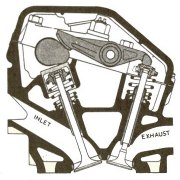history of valve..
Multi-valve engines
started life in 1912 on a Peugeot GP racing car. It was then briefly used by
the pre-war Bentley and Bugatti. However, mass production on road cars came as
late as 1970s - Triumph Donomite Sprint (1973), Chevrolet Cosworth Vega (1975),
Lotus Esprit (1976), Fiat 131 Abarth (1976) and BMW M1 (1979) were the earliest
adopters.
Triumph Donomite Sprint was the earliest road car
to feature multi-valve technology. Its 2-liter four-pot engine featured 16
valves but just one camshaft, unlike the DOHC designs popular on contemporary
racing engines. The intake valves were driven directly by the camshaft, while
the exhaust valves were driven by the same camshaft through rocker arms. Today,
Honda's SOHC 16-valve engines still employ the same design.
By the mid-1980s, 4 valves per cylinder virtually
became standard on high-performance cars, such as Ferrari 308 GTB Quattrovalvole
(1982), BMW M635CSi (1983), Ferrari 288 GTO (1984), Mercedes 190E 2.3-16
(1984), Saab 9000 (1984, also the first to combine 4-valve and turbo on
production car), BMW M5 (1985), Ferrari Testarossa (1985), Lamborghini Countach
QV (1985) and Volkswagen Golf GTi 16V (1985), let alone those Group B rally
specials.
However, it was the Japanese who came first to put multi-valve technology on mass production cars that everybody can afford. Honda Civic adopted 3-valve engines as standard in 1983 and 4-valve engines in 1987. Toyota mass-marketed its high-performance 1.6-liter 16V engine on Corolla coupe / Truneo (1983) and MR2 (1984), then equipped the bread-and-butter Corolla with 4-valve engines in 1987. They standardized multi-valve engines nearly a decade earlier than Western car makers !
However, it was the Japanese who came first to put multi-valve technology on mass production cars that everybody can afford. Honda Civic adopted 3-valve engines as standard in 1983 and 4-valve engines in 1987. Toyota mass-marketed its high-performance 1.6-liter 16V engine on Corolla coupe / Truneo (1983) and MR2 (1984), then equipped the bread-and-butter Corolla with 4-valve engines in 1987. They standardized multi-valve engines nearly a decade earlier than Western car makers !
WHAT IS VALVE ?
The valves and
valve-operating mechanism by which an internal combustion engine takes air or
fuel-air mixture into the cylinders and discharges combustion products to the
exhaust. Valve, device for controlling the flow of fluids (liquids and
gases). Valves vary in construction and size depending upon their function.
Some are classified according to their method of operation or design, e.g.,
butterfly, gate, globe, lift, needle, piston, and slide valves. Valves are also
named for the functions they perform, e.g., check valve (which permits flow in
one direction only) and cut-off, bypass, exhaust, intake, safety, and throttle
valves. Valves are operated automatically, by hand, or by special mechanism.
Valves are employed in the carburettor, diesel engine, internal-combustion
engine, pump, and steam engine. In Great Britain an electron tube may be
referred to as a valve. In anatomy and physiology the term valve includes
the flaps of tissue that help to control the direction of the flow of blood in
the heart.
Mechanically, an
internal combustion engine is a reciprocating pump, able to draw in a certain
amount of air per minute. Since the fuel takes up little space but needs air
with which to combine, the power output of an engine is limited by its
air-pumping capacity. The flow through the engine should be restricted as
little as possible. This is the first requirement for valves. The second is
that the valves close off the cylinder firmly during the compression and power
strokes. Internal combustion engine A prime mover, the fuel for which is
burned within the engine, as contrasted to a steam engine, for example, in
which fuel is burned in a separate furnace.
The most numerous of
internal combustion engines are the gasoline piston engines used in passenger
automobiles, outboard engines for motor boats, small units for lawn mowers, and
other such equipment, as well as diesel engines used in trucks, tractors,
earth-moving, and similar equipment.
 In most
four-stroke engines the valves are the inward-opening poppet type, with the
valve head ground to fit a conical seat in the cylinder block or cylinder head.
The valve is streamlined and as large as possible to give maximum flow, yet of
low inertia so that it follows the prescribed motion at high engine speed.
In most
four-stroke engines the valves are the inward-opening poppet type, with the
valve head ground to fit a conical seat in the cylinder block or cylinder head.
The valve is streamlined and as large as possible to give maximum flow, yet of
low inertia so that it follows the prescribed motion at high engine speed.
Engine valves
are usually opened by cams that rotate as part of a camshaft, which may be
located in the cylinder block or cylinder head. Riding on each cam is a cam
follower or valve lifter, which may have a flat or slightly convex surface or a
roller, in contact with the cam. The valve is opened by force applied to the
end of the valve stem. A valve rotator may be used to rotate the valve slightly
as it opens. In engines with the camshaft and valves in the cylinder head, the
cam may operate the valve directly through a cup-type cam follower. To ensure
tight closing of the valve even after the valve stem lengthens from thermal
expansion, the valve train is adjusted to provide some clearance when the
follower is on the low part of the cam.











